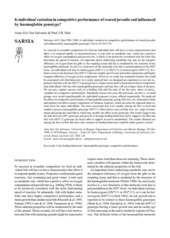| dc.description.abstract | To succeed in scramble competition for food an individual fish will have to have characteristics that allow it to respond rapidly to encountered prey. A trait such as metabolic rate, which has a positive effect on oxygen consumption and growth rate, is likely to be positively correlated with the traits that determine the speed of reaction. An important factor underlying metabolic rate may be the transport efficiency of oxygen from the gills to the respiring tissue and this is mediated by the structure of the haemoglobin molecule. In cod, two structures of this molecule exist due to polymorphism at the HbI* locus. An individual cod may be homozygous (HbI*1/1 or HbI*2/2) or heterozygous (HbI*1/2). Evidence exists in the literature that HbI*2/2 fish have higher growth rate and earlier maturation and higher transport efficiency of oxygen at low temperature. However, no study has examined whether this could be associated with fish behaviour. In a study reported here we designed an experiment to test the hypothesis that fish with the HbI*2/2 genotype have a higher motivation to feed and are better competitors than individuals with the other haemoglobin genotypes and that they will eat a larger share of the prey. We use prey capture success early in a feeding trial and the rank of the first prey taken, as proxyvariables for competitive performance. Randomly chosen one-year-old cod Gadus morhua L. in small groups were tested experimentally for individual responses to prey offered sequentially. We analysed the effect on competitive performance of haemoglobin genotype, group, fish size, sex, maturation status and unobserved effects using Components of Variance Analysis, which accounts for repeated observations from the same individuals. The most successful fish were usually among the first to feed and tended to possess haemoglobin genotype HbI*2/2. Other factors such as body size, sex, stage of maturation and group also had effects which may modify the effect set by genotype. Our results suggest that the link between HbI* genotype and growth is through feeding behaviour and it supports the idea that fish with HbI*2/2 genotype are better able to support an active metabolism. The results obtained are among the first on fish that show that variation in feeding behaviour could be under genetic control. | en_US |
